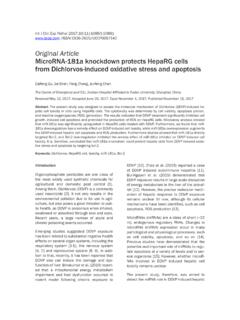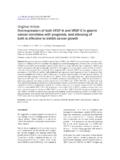Transcription of Original Article Isolation of myeloid-derived …
1 Int J Clin Exp Pathol 2014;7(11) /ISSN:1936-2625/IJCEP0002571 Original Article Isolation of myeloid - derived suppressor cells subsets from spleens of orthotopic liver cancer-bearing mice by fluorescent-activated and magnetic-activated cell sorting: similarities and differencesYaping Xu*, Wenxiu Zhao*, Duan Wu, Jianfeng Xu, Suqiong Lin, Kai Tang, Zhenyu Yin, Xiaomin WangDepartment of Hepatobiliary Surgery, Zhongshan Hospital, Xiamen University, Fujian Provincial Key Laboratory of Chronic Liver Disease and Hepatocellular Carcinoma (Xiamen University Affiliated Zhongshan Hospital), Xiamen, China. *Equal September 17, 2014; Accepted November 1, 2014; Epub October 15, 2014; Published November 1, 2014 Abstract: myeloid - derived suppressor cells (MDSCs) are a heterogeneous population of immature myeloid cells that commonly expand during tumor development and that play a critical role in suppression of immune responses.
2 MDSCs can be classified into two groups: Mo-MDSCs and G-MDSCs. These cells differ in their morphology, pheno-type, differentiation ability, and immunosuppressive activity, and inhibit immune responses via different mecha-nisms. Therefore, identifying an effective method for isolating viable Mo-MDSCs and G-MDSCs is important. Here, we demonstrated the differences and similarities between fluorescence-activated cell sorting (FACS) and magnetic-activated cell sorting (MACS) in sorting G-MDSCs and Mo-MDSCs. Both MACS and FACS could obtain G-MDSCs and Mo-MDSCs with high viability and purity. A high yield and purity of G-MDSCs could be obtained both by using FACS and MACS, because G-MDSCs are highly expressed in the spleen of tumor-bearing mice. However, Mo-MDSCs, which comprise a small population among leukocytes, when sorted by MACS, could be obtained at much greater cell number, although with a slightly lower purity, than when sorted by FACS.
3 In conclusion, we recommended using both FACS and MACS for isolating G-MDSCs, and using MACS for Isolation of Mo-MDSCs. Keywords: Fluorescent-activated cell sorting (FACS), granulocytic, magnetic-activated cell sorting (MACS), mono-cytic, myeloid - derived suppressor cell, separationIntroduction myeloid - derived suppressor cells (MDSCs), a newly identified kind of immune inhibitory cell, play an important role in the tumor immune-escape process [1]. MDSCs are one of the main populations of myeloid cells, comprising pro-genitor cells, immature macrophages, imma-ture granulocytes, and immature dendritic cells [2]. In mice, these cells are commonly defined as CD11b+Gr-1+ cells [3-5], which consist of two major subsets: Ly6G+Ly6 Clow granulocytic MD- SCs (G-MDSCs) and Ly6G-Ly6 Chigh monocytic MDSCs (Mo-MDSCs) [4, 6]. In most tumor mod-els, the expansion of MDSCs predominantly involves G-MDSCs (70-80%) [4, 7].
4 Importantly, these two subsets of cells inactivate the immune response via different mechanisms [8, 9]. G-MDSCs produce increased levels of reac-tive oxygen species (ROS) and undetectable lev-els of nitric oxide (NO), whereas Mo-MDSCs generate increased levels of NO, but undetect-able levels of ROS [4, 10-13].It has been reported that, in some tumor mod-els systems, the relative frequency of Mo- MDSCs, as compared to G-MDSCs, is reduced in the blood compared to the spleen (1:11 blood versus 1:5 spleen), and that this relative fre-quency is the lowest in the tumor (1:113) [14]. The percentages of Mo-MDSC are significantly less in immune organs in comparison with those of G-MDSCs in tumor-bearing mice. This poses a challenge for obtaining sufficient cells for analyses. Therefore, an efficient method for separating G-MDSCs and Mo-MDSCs is in great of MDSCs by different ways7546 Int J Clin Exp Pathol 2014;7(11):7545-7553At present, there are some feasible ways for obtaining subsets of MDSCs.
5 1) A phycoery-thrin (PE)-positive Isolation Kit (STEMCELL Technologies; Vancouver, Canada) [15]; 2) myeloid - derived suppressor Cell Isolation Kit for mouse MDSCs via magnetic-activated cell sorting (MACS) from Miltenyi Biotec (Bergisch Gladbach, Germany) [16]; 3) fluorescence-acti-vated cell sorting (FACS) [17]. However, the rela-tive efficiency of these methods has not been investigated to the present study, we compared FACS and MACS methods for obtaining pure CD11b+Ly- 6G+Ly6 Clow G-MDSCs and CD11b+Ly6G-Ly6 Chigh Mo-MDSCs, and analyzed the cell survival rate, cell purity, and cell and methodsAnimals and cell linesAll experimental protocols were reviewed and approved by our institutional review board. All animal experimental protocols were performed in compliance with the Guidelines for the Institutional Animal Care and Use Committee of Xiamen (H-2d, haplotype) mice were purchased from the National Rodent Laboratory Animal Resources, Shanghai, China.
6 Adult male ani-mals, aged 8-12 weeks, were used. The mouse hepatoma cell line, H22, was purchased from Shanghai Cell Bank, Chinese Academy of Sciences, and was maintained in RPMI 1640 (HyClone, Beijing, China), supplemented with 10% fetal bovine serum (FBS), 100 U/mL peni-cillin, and 100 g/mL streptomycin, as previ-ously described [18]. In situ hepatic tumor modelThe HCC model was created by direct intrahe-patic injection of mouse hepatoma H22 cells (originating from BALB/c mice of the H-2d hap-lotype), as previously described [19]. Mice were anesthetized by intraperitoneal injection of 5% chloral hydrate ( mL/10 g body weight), and opened via a midline incision to expose the liver. One million H22 cells, suspended in 30-50 L of phosphate-buffered saline (PBS) was slowly injected under the hepatic capsule into the upper left lobe of the liver, using a 28-gauge needle.
7 A pale, whitish coloring could be observed at the point of injection under the hepatic capsule. A gentle compression was applied for 30 s with a cotton applicator to avoid bleeding and reflux of the cells. The abdo-men was closed with a 5-0 silk suture. The mice were observed for 2-3 h and then returned to the storage facilities. Ten days later the mice were sacrificed and the anatomy studied. Separation of spleen cells Splenocytes were isolated from the spleens of tumor-bearing mice by disaggregation into 10 mL of RPMI 1640 complete medium. Eryth- rocytes were lysed with Red Blood Cell Lysis Buffer (Beyotime, Nanjing, China). Then, sple-nocytes were mashed through 70- m cell strainers to obtain single-cell separationFor MACS separation, the MDSC Isolation Kit (Miltenyi Biotec, Bergisch Gladbach, Germany) and biotinylated rat anti-mouse Ly6G and Ly6C (BD Biosciences, San Jose, CA) were were isolated according to the manu-facturer s instructions (MDSC kit).
8 For Ly6G separation, up to 1 108 total cells were centri-fuged at 300 g for 10 min at 4 C. The cell pellets were resuspended in 700 L of PBS (pH ), bovine serum albumin (BSA), and 2 mM EDTA. FCR blocking reagent (50 L) was added, mixed well, and incubated for 10 min at 4 C. After incubation, 100 L of biotin-conju-gated anti-Ly6G antibody was added and the cells incubated for a further 15 min at 4 C. Cells were washed by adding 10 mL of buffer and centrifuging at 300 g for 10 min at 4 C. The labeled cells were resuspended in 800 L of buffer; then, 200 L of anti-biotin micro-beads was added, mixed well, and incubated for 10 min at 4 C. Cells were washed by adding 10-20 mL of buffer and centrifuging at 300 g for 10 min at 4 C. The cell pellets were then resuspended in 500 L of separation of Mo-MDSCs, the cells remain-ing after the Ly6G-separation were centrifuged at 300 g for 10 min at 4 C.
9 The cell pellet was resuspended in 400 L of buffer, after which 10 L of biotin-conjugated rat anti-mouse Ly6G and Ly6C antibodies was added (BD Bio- sciences, San Jose, CA). Samples were mixed well and incubated for 10 min at 4 C. Cells were then washed by adding 10 L of buffer and centrifuging at 300 g for 10 min at 4 C. Isolation of MDSCs by different ways7547 Int J Clin Exp Pathol 2014;7(11):7545-7553 The cell pellet was resuspended in 900 L of buffer, to which was added 100 L of strep- tavidin micobeads. Samples were mixed well and incubated for 15 min at 4 C. Cells were washed again by adding 10-20 mL of buffer and centrifuging at 300 g for 10 min at 4 C. The cell pellet was resuspended in 500 L of buffer, and magnetic separation ( ) was then performed as the instructions supplied by the MDSC kit. The collected cells were separationFor flow cytometric sorting, 1 107 cells/mL splenocytes from tumor-bearing mice were stained with anti-CD11b-APC (BD Biosciences), anti-Ly6G-FITC (BD Biosciences), and anti-Ly6C-PE (BD Biosciences) antibodies for 20 min on ice in staining buffer (1% FBS in PBS).
10 Cells were then washed with PBS, and the sam-ples were then sorted using a BD Influx. To obtain pure cells, the drop pure sort mode was chosen. The cells were sorted by gating on P1 (CD11b+Ly6G-Ly6 Chigh) as well as by gating on P2 (CD11b+Ly6G+Ly6 Clow).Analysis of purity of cells separated by MACS and FACSA fter the magnetic separation, cells were labe- led with APC-conjugated anti-CD11b, FITC-conjugated anti-Ly6G, and PE-conjugated anti-Ly6C antibodies, and were analyzed by FACS. Cells separated by flow cytometry were ana-lyzed immediately. The purity of G-MDSCs was calculated using the formula CD11b+% CD11b+Ly6G+Ly6 Clow%, while that of Mo-MDSCs was CD11b+% CD11b+Ly6G-Ly6C+%.Analysis of the survival of MACS- and FACS-separated cellsImmediately after sorting, cells were detected, and the number and the survival rate deter-mined using an ADAM-MC (Digital Bio Technology, Seoul, Korea) according to the manufacturer s stain for determining MDSC morphology Cell smears were prepared on sterile slides and air dried, where after the cells were stained with Wright-Giemsa stain solution for 3-4 min, followed by addition of mL of distilled water for 5-10 min; the latter step was repeated once more.
















